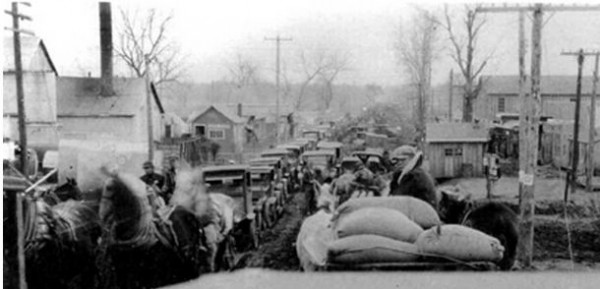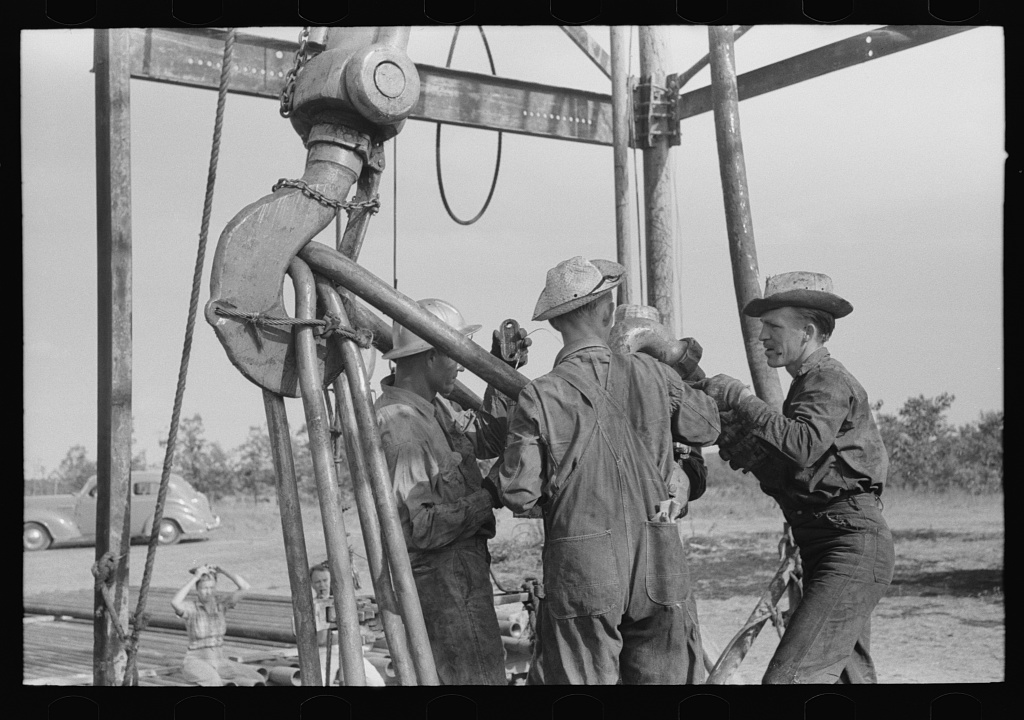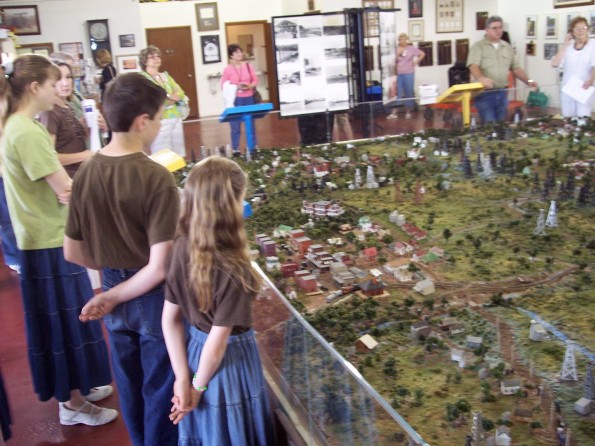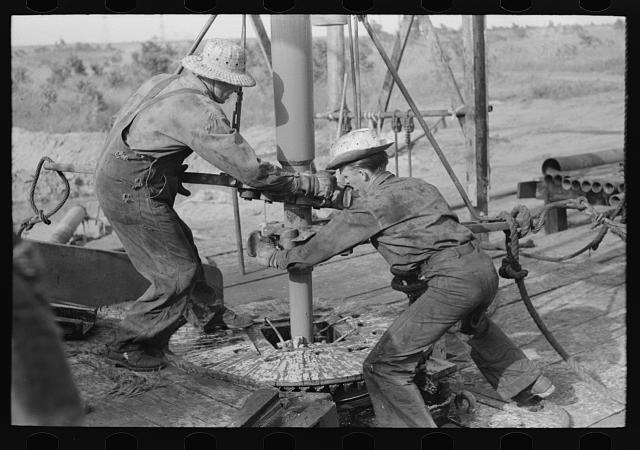Giant oilfields bring Oklahoma petroleum boom during Great Depression.
Many oil and natural gas discoveries followed the Indian Territory’s first oil well drilled at Bartlesville in 1897, and especially after statehood came a decade later. None of Oklahoma’s 1920s oilfields compares to the economic impact of the Greater Seminole Area oil boom.
Although oil from the 1897 discovery in Indian Territory could not get to refineries for two years (lacking transportation infrastructure), the first Oklahoma oil well brought a surge in exploratory drilling.
More oilfield discoveries followed, including the Red Fork Gusher of 1901, which helped in Making Tulsa “Oil Capital of the World,” but Seminole area oilfields eclipsed them all.

Prosperity brought traffic jams to Seminole, Oklahoma, in the mid-1920s when new oilfields “swung the United States’ oil inventory from scarcity to surplus.” Photo courtesy Oklahoma Historical Society.
Interest in exploring for oil in the struggling farming region accelerated on March 17, 1923, when a wildcat well, the Betsy Foster No. 1, produced 2,800 barrels of oil a day near Wewoka, the county seat of Seminole County.
The oilfield discovery well south of Oklahoma City led to others, including a widely publicized discovery on July 16, 1926. The Seminole region’s Fixico No. 1 well revealed the extensive, petroleum-rich Wilcox sands at a depth of 4,075 feet.
Initially flowing at 6,120 barrels of oil a day, the Independent Oil Company well of R.F. Garland was one of five oil reservoirs discovered in the Seminole area by 1927.
Seminole Field leads World
Seminole area oilfields at their height would account for 2.6 percent of the world’s oil supply — and also cause oil prices to fall as low as 15 cents per barrel.
The name “Greater Seminole Field” was adopted in 1926, after “operators from the various fields met to discuss voluntary proration, well spacing, and production control,” according to the Oklahoma Historical Society (OHS).
By 1935, the new oilfields around Seminole became the largest supplier of oil in the world. More than 60 petroleum reservoirs were found in 1,300 square miles, and seven were “giants,” each producing millions of barrels of oil.
Seismic technology first helped find oil on December 4, 1928, when it revealed details of the Viola limestone formation near Seminole, resulting the world’s first oil discovery in a geological structure that had been identified by reflection (learn more in Exploring Seismic Waves).
The series of discoveries included strikes in the Hunton lime formation by Indian Territory Illuminating Oil Company in March 1926, followed by a July discovery of Wilcox sand production by Amerada Petroleum Company nearby.

“Oil workers working on lowered traveling block” at a well in Seminole oilfield, August 1939. Farm Security Administration photo by Russell Lee (1903-1986) courtesy Library of Congress.
“In rapid succession came discoveries of the Searight, Earlsboro, Bowlegs and Little River reservoirs,” according to a 1977 granite monument near the entrance to Seminole Municipal Park. The discoveries brought 20,000 oilfield workers to Seminole County — and created several classic petroleum boom towns.
The prosperity of these discoveries transformed life in many central Oklahoma farming communities.

Closed in 2019, the Oklahoma Oil Museum in Seminole once included a volunteer-made diorama of small towns near seven of Oklahoma’s 20 “giant” oilfields. Photo by Kris Wells.
Prior to the oil boom period, the greater Seminole area was one of the poorest economic areas in Oklahoma. The Seminoles were the smallest in numbers and the lowest on the economic scale of the Five Civilized Tribes.
“By the 1920s, farmers in Seminole County, like those elsewhere, were beginning to feel the pinch of hard times created by falling prices for farm produce,” noted historian Louise Welsh in A History of the Greater Seminole Oil Field.
“An advertisement of the First National Bank in the Seminole County News urged people to have clear heads, stout hearts and busy hands, and to remember that greater problems had been met and solved,” Welsh added.

Oilfield roughnecks at work during Oklahoma’s Greater Seminole Area boom of the 1930s. Photo by Russell Lee for Farm Security Administration, courtesy Library of Congress.
“It was quite natural that, under such stress, the prospect of finding oil should occasion both excitement and hope, since the prospect of leasing his land might provide the necessary funds with which the hard-pressed farmer could pay off his mortgage,” Welsh reported.
Although the area’s first discovery came near Wewoka in 1923, and the Cromwell oilfield was developed in 1924, and leasing activity continued around Seminole, it was not until 1926 that the hope for a giant oilfield discovery was realized.
“It was the Independent Oil and Gas Company’s No. 1 Fixico, whose 6,120 barrels a day from the Wilcox created a real bonanza, that precipitated the Seminole boom,” Welsh explained. The Seminole County population increased from 23,808 in 1920 to 79,621 in 1930.
At its height, the Seminole City oilfield accounted for 2.6 percent of the world’s oil production, Welsh added, noting massive Oklahoma production glutted oil markets and resulted in a price collapse to as low as 15 cents per barrel. The oilfields were then placed under state control.
“Thus, the conservation movement, as far as the oil industry is concerned, started in Oklahoma and largely in the greater Seminole areas,” Welsh concluded. Dedicated volunteers operated the Oklahoma Oil Museum at 1800 Hwy. 9 West in Seminole.
_______________________
Recommended Reading: A History of the Greater Seminole Oil Field (1981); Oil And Gas In Oklahoma: Petroleum Geology In Oklahoma
(2013); Oil in Oklahoma
(1976). As an Amazon Associate, AOGHS earns a commission from qualifying purchases.
_______________________
The American Oil & Gas Historical Society (AOGHS) preserves U.S. petroleum history. Please become an AOGHS annual supporter and help maintain this energy education website and expand historical research. For more information, contact bawells@aoghs.org. © 2025 Bruce A. Wells.
Citation Information – Article Title: “Seminole Oil Boom.” Authors: B.A. Wells and K.L. Wells. Website Name: American Oil & Gas Historical Society. URL: https://aoghs.org/petroleum-pioneers/seminole-oil-boom. Last Updated: July 8, 2025. Original Published Date: April 29, 2014.



